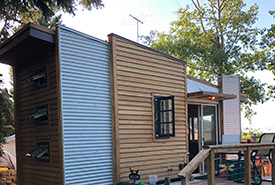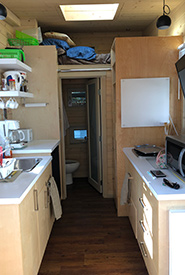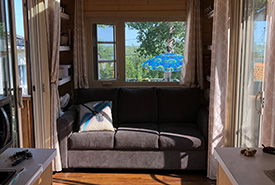Tiny house, smaller footprint

This year, my family tested our bond and squeezed into a “tiny house” for the long weekend. (Photo by Maia Herriot)
In celebration of Family Day this year, my family tested our bond and squeezed into a “tiny house” for the long weekend.
According to Tiny Home Builders, the tiny house movement is “the architectural and social movement that advocates living simply in small homes.” The tiny house we spent the weekend in was an Airbnb on a property at Regina Beach, Saskatchewan, just 30 minutes from our homes in Regina.
We were interested in experiencing a tiny house first-hand, not just because the houses look cool, but because they offer a more sustainable way of living. The “living simply” aspect of the tiny house movement is key. I think we all have those moments when we look around our home and think, “Where did all of this stuff come from?” And then, “How can I ever get rid of it?”
Related blog posts
A large part of the tiny house movement is eliminating unnecessary “stuff” from your life. This practice has the added benefit of being more sustainable and eco-friendly, reducing waste and your general urge or ability to purchase manufactured materials that will outlast us all.
Pausing while washing dishes to step out of the house so my sister could get to the bathroom felt like an inconvenience the first time, but my family and I got used to spending more time outside than inside pretty quickly. The easy transition got me thinking about housing situations in other countries, where the norm is to live with limited personal space, even if you can afford more. This includes intergenerational families sharing housing or a cultural emphasis on spending more time living in the community rather than at home.

The kitchen in our tiny house (Photo by Maia Herriot)
In North America, the ideal living situation includes everyone having their own room, maybe even their own bathroom, and enough space in common areas like the kitchen for multiple people at once. But in many other countries, homes have just enough space to sleep and make food.
The Japanese government's guidelines state that the ideal amount of living space per person is 40 square metres (430 square feet) for an urban dweller. According to a 2017 survey, the average size of a Canadian home is 166 square metres (1,792 square feet). Out of the nine countries surveyed, Canadian respondents had the second largest average living area per person. At 57 square metres (618 square feet) per person, the U.S. had the largest average living area.
The average living area per person in Canada is almost four times as large as the tiny house we stayed in that weekend, almost 19 square metres (200 square feet) more than Japan’s ideal living space size and twice Japan’s minimum (25 square metres (269 square feet)). And yet, 42 per cent of Canadians surveyed want bigger homes than they already have.

Having so little indoor living space meant that we had to do most of our living outside. (Photo by Maia Herriot)
My biggest takeaway from our weekend at the tiny house is that we didn’t actually spend three days in a 15-square metre (160-square foot) space. We spent three days on the deck, at the beach, on walks or in outdoor hammocks. Having so little indoor living space meant that we had to do most of our living outside. The experience reminded me of seeing the way people lived in Italy or Cuba, talking to their neighbours out on the stoop in the evenings instead of being cooped up in their private rooms in their private homes. It also reminded me of going tenting, where you have to collapse your sleeping space during the day so you can’t hide indoors even if you wanted to. After spending all week in an office and almost every weeknight indoors, being forced outside by the constraints of the tiny house felt like a welcome and necessary change.
Organizations like the Nature Conservancy of Canada (NCC) work to conserve land so that every natural thing — every bird, tree and grass species — has the space they need to sustain themselves. We, as individuals — if we are privileged enough to make a conscious choice about housing — can do our part to leave more room for other species, only take up as much room as we really need and share more. We can be space conservationists, be more mindful about how much room we really need and spend more time out in the world in places we share with the birds, trees and each other.


